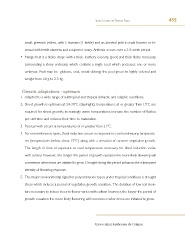Page 455 - FRUTAS DEL TRÓPICO
P. 455
455
shoRt couRse on tRopical fRuits
small, greenish yellow, with 5 stamens (1 fertile) and an aborted pistil in male flowers or bi-
sexual with fertile stamens and a superior ovary. Anthesis occurs over a 3-8 week period.
• Mango fruit is a fleshy drupe with a thick, leathery exocarp (peel) and thick fleshy mesocarp
surrounding a stony endocarp which contains a single seed which possesses one or more
embryos. Fruit may be globose, oval, ovoid-oblong; the peel green to highly colored and
weight from 60 g to 2.3 kg.
Climatic adaptations —optimum
1. Adapted to a wide range of subtropical and tropical climactic and edaphic conditions.
2. Shoot growth is optimum at 24-30°C (day/night); temperatures at or greater than 15°C are
required for shoot growth; increasingly warm temperatures increase the number of flushes
per unit time and reduces their time to maturation.
3. Root growth occurs at temperatures of or greater than 21°C.
4. For monembryonic types, floral induction occurs in response to cool nonfreezing temperatu-
res (temperatures below about 15°C) along with a cessation of summer vegetative growth.
The length of time of exposure to cool temperature necessary for floral induction varies
with cultivar however, the longer the period of growth cessation the more likely flowering will
commence when trees are initiated to grow. Drought during this period enhances the subsequent
intensity of flowering response.
5. The major environmental signal for polyembryonic types under tropical conditions is drought
stress which induces a period of vegetative growth cessation. The duration of low soil mois-
ture necessary to induce trees to flower varies with cultivar however, the longer the period of
growth cessation the more likely flowering will commence when trees are initiated to grow.
Universidad Autónoma de Chiapas

